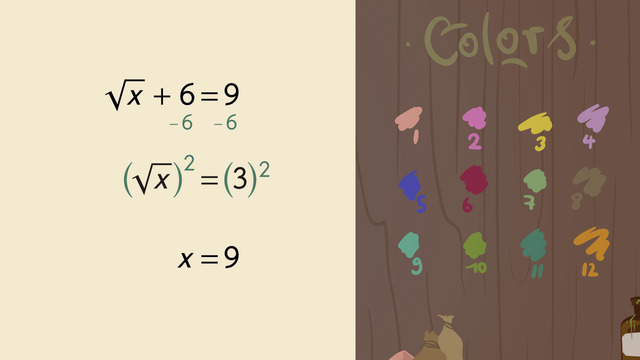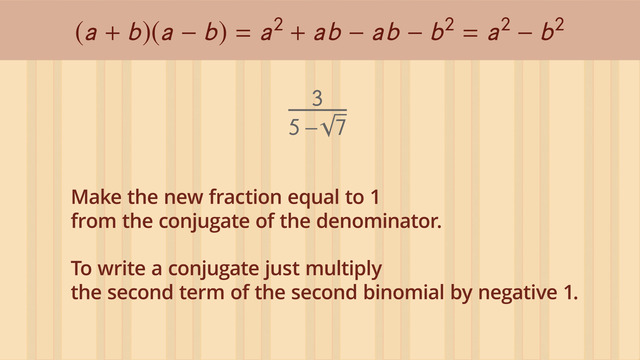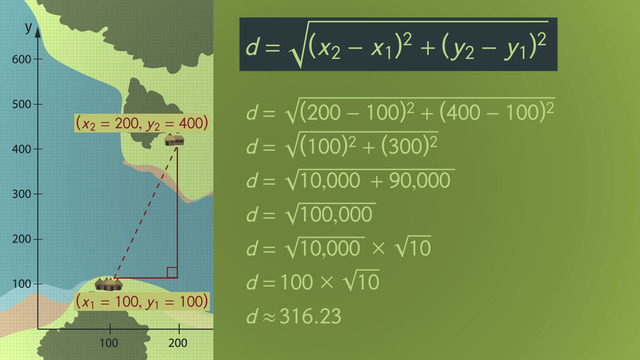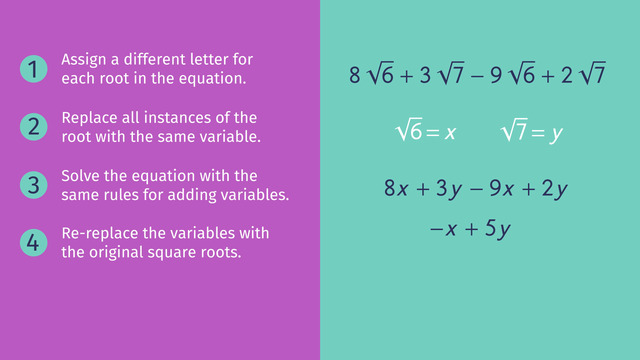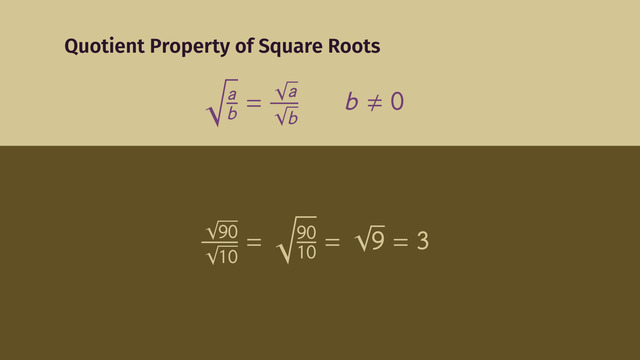The Midpoint Formula


Basics on the topic The Midpoint Formula
To find the midpoint of a segment in a plane, we should use the midpoint formula. The coordinates of the endpoints of the segment play an important role in the formula; the midpoint formula states that the midpoint of a segment is the average of the x- and y – coordinates of its endpoints pairing together.
For example, let’s find the midpoint of the segment on a plane whose endpoints are the coordinates (5, 1) and (7, 3). We know that the x- coordinates of the points are 5 and 7 and the y – coordinates are 1 and 3. Getting the average of both x – and y – coordinates, we get (5+7)/2 = 6 and (1+3)/2 = 2. Pairing our answers, we then have that the midpoint of the segment is (6, 2).
The midpoint formula is essential in many real life situations. For example, you want to cut a stick in half but you don’t have any measuring devices. In this situation, you can still cut the stick in half by placing the stick on the graphing paper and determine the coordinates of its ends. Then apply the midpoint formula to find the midpoint of the stick.
Represent complex numbers and their operations on the complex plane.
CCSS.MATH.CONTENT.HSN.CN.B.6
Transcript The Midpoint Formula
Meet Imke, she’s an avid rock climber and a hobby ornithologist. You know - she’s into birds. Imke wants to see a very rare bird that makes its nest in a cave on Mount Massive in Colorado. So she must plan her climb carefully for the arduous journey. The path to the nest is divided into three segments. In order to ensure a safe ascent, Imke will need to use cams to secure her rope to the mountain at different points along the way.
Midpoint Formula
Imke can use the Midpoint Formula to help her. Take a look at this map of the route. Notice the coordinate grid? We're given the ordered pairs for the location of the starting point, and three lookout points. Okay, let’s tackle the first segment. Imke wants to determine three, equidistant locations along the route to place her cams.The starting point is at position (1, 2) and the first lookout point is at (11,8).
Or, being more abstract, the coordinates of the two points are (x1, y1) and (x2, y2).,To find the exact midpoint between these two points, you can use the Midpoint Formula, where you add the two x-values and divide by 2 to get the x-coordinate; as well as adding the two y-values and then again dividing by 2 to get the y-coordinate.
Example 1
Let's plug in our known ordered pairs (1, 2) and (11, 8) for x1, x2, y1 and y2. Now simplify to find the midpoint of the first segment. Imke should place a cam at the location of the ordered pair (6, 5). Now, to determine where Imke should place another cam, we need to find the midpoint between the midpoint we just found and the starting point.We already know the starting point is located at the ordered pair (1,2) so we plug in the x- and y-values of the starting point and the midpoint, respectively: (1, 2) and (6, 5) and we simplify. Imke will need to place a cam at the ordered pair (3.5, 3.5).
Now let's figure where Imke should place her last cam on this segment: We already know the first midpoint cam's coordinates and the coordinates of the first lookout point. So we'll need to use the ordered pairs, (6, 5) and (11, 8) to determine the final midpoint. Do the math and the third cam should be placed at the ordered pair (8.5, 6.5).
Great. We've calculated the location of three points that are equidistant from each other. We did this by first diving the segment in half and then dividing the resulting segments in half again. Imke knows exactly where to place her cams to ensure a safe climb.
Example 2
Imke plans to rest for the night at a location smack dab in the middle of the first and second lookout points. The first lookout point is at (11, 8) and the second is located at (-3, 12). Figuring out where Imke needs to set up camp is easy; we just use the midpoint formula with the coordinates of the lookout points to calculate the midpoint. Be careful with the signs! Sweet dreams at (4,10), Imke! After a rejuvenating rest, Imke is ready to tackle the third and last segment.
Example 3
The bird’s nest is supposed to be right in the middle of the third segment between lookout point (-3,12) and lookout point (-3, 17). Imke can use the midpoint formula again. But this time she sees a similarity in the coordinates. Since the x-values of both the endpoints are the same, she knows the x-value of the midpoint will be the same too, negative 3. Now she just needs to calculate the midpoint of the y-values by finding the average of the sum of 12 and 17, which is 14.5.
Finally, Imke is almost there. Just a little bit further. Oh!! Look at the baby birds!! They are just so adorable! Oh no! It's the momma, and lemme tell you, she's one angry bird!!
The Midpoint Formula exercise
-
Determine the midpoint.
HintsJust look at the example beside if both points have the same $x$-coordinate.
The $y$-coordinate is the arithmetic middle of $-2$ and $4$, namely $1$.
For the given points on the left the midpoint is $(-3,14.5)$.
You get the $y$-coordinate as follows:
$14.5=\frac{12+17}{2}=\frac{29}2$.
In general the midpoint formula for two points $(x_1,y_1)$ and $(x_2,y_2)$ is given by
$\left(\frac{x_1+x_2}2,\frac{y_1+y_2}2\right)$
SolutionThe first look out point is $(11,8)$ and the second one $(-3,12)$.
Use the midpoint formula with the coordinates of the given points:
- We sum the $x$-coordinates and divide the sum by $2$. So we get $\frac{11-3}2=\frac82=4$.
- We proceed in the same fashion with the $y$-coordinates to get $\frac{8+12}2=\frac{20}2=10$.
-
Calculate the three points.
HintsThe midpoint formula for two points $P_1=(x_1,y_1)$ and $P_2=(x_2,y_2)$ is given by
$\left(\frac{x_1+x_2}2,\frac{y_1+y_2}2\right)$.
You have to use this midpoint formula three times.
- Once for the midpoint $M$ between $P_1$ and $P_2$.
- Next for the midpoint between $P_1$ and $M$.
- Lastly for the midpoint between $M$ and $P_2$.
The coordinates of $M$ are whole numbers.
SolutionImke wants to divide the path starting with $P_1=(1,2)$ and ending with $P_2=(11,8)$ into three equidistant points. So first we have to find the midpoint $M$ of those two points and after two more midpoints: one between the starting point $P_1$ and the midpoint $M$ and the other between the midpoint $M$ and the ending point $P_2$.
Let's start with the midpoint between $P_1$ and $P_2$.
We use the midpoint formula,
$\left(\frac{x_1+x_2}2,\frac{y_1+y_2}2\right)$,
and put the coordinates in
$M=\left(\frac{1+11}2,\frac{2+8}2\right)=\left(\frac{12}2,\frac{10}2\right)=\left(6,5\right)$.
Next we use the midpoint formula again for the starting point and $M=(6,5)$:
$\left(\frac{1+6}2,\frac{2+5}2\right)=\left(\frac{7}2,\frac{7}2\right)=\left(3.5,3.5\right)$.
And again for $M=(6,5)$ and the ending point:
$\left(\frac{6+11}2,\frac{5+8}2\right)=\left(\frac{17}2,\frac{13}2\right)=\left(8.5,6.5\right)$.
-
Find the midpoints of the given points.
HintsIn general the midpoint of two points $P_1=(x_1,y_1)$ and $P_2=(x_2,y_2)$ is given by the midpoint formula:
$\left(\frac{x_1+x_2}2,\frac{y_1+y_2}2\right)$.
Pay attention to the sign.
If two points have a coordinate in common, then that coordinate stays the same for the midpoint.
The order of adding the coordinates doesn't matter at all.
SolutionThe midpoint formula for two points $P_1=(x_1,y_1)$ and $P_2=(x_2,y_2)$ is given by
$\left(\frac{x_1+x_2}2,\frac{y_1+y_2}2\right)$.
Let's use this formula for a few examples:
For $P_1=(-3,2)$ and $P_2=(2,-3)$, we get the midpoint
$M=\left(\frac{-3+2}2,\frac{2+(-3)}2\right)=\left(\frac{-1}2,\frac{-1}2\right)=(-0.5,-0.5)$.
The points $P_1=(2,2)$ and $P_2=(2,4)$, we get the midpoint
$M=\left(\frac{2+2}2,\frac{2+4}2\right)=\left(\frac{4}2,\frac{6}2\right)=(2,3)$.
The midpoint of $P_1=(2,-4)$ and $P_2=(6,8)$ is given by
$M=\left(\frac{2+6}2,\frac{-4+8}2\right)=\left(\frac{8}2,\frac{4}2\right)=(4,2)$.
The midpoint of the last two points $P_1=(3,3)$ and $P_2=(-7,9)$ is given by
$M=\left(\frac{3+(-7)}2,\frac{3+9}2\right)=\left(\frac{-4}2,\frac{12}2\right)=(-2,6)$.
-
Calculate the meeting point of Imke and her friend.
HintsYou have to add the coordinates and divide by $2$.
The $x$-coordinate is a rational number while the $y$-coordinate is a natural number.
Here you see the calculation of the midpoint of $(3,7)$ and $(7,8)$.
SolutionHere we have to determine the midpoint of $(2,7)$ and $(9,15)$. To do this, we use the midpoint formula. This means to get a coordinate of the midpoint we add the corresponding coordinates of those points and divide the resulting sum by $2$:
$M=\left(\frac{2+9}2,\frac{7+15}2\right)=\left(\frac{11}2,\frac{22}2\right)=(5.5,11)$.
-
Identify the midpoint formula.
HintsIf both points have the same $x$- or $y$-coordinate, you get the midpoint as follows:
- The common coordinate stays the same for the midpoint.
- The coordinate not in common is the arithmetic middle of the given (two) coordinates.
For example, the midpoint of $(4,4)$ and $(6,10)$ is $(5,7)$.
SolutionThe midpoint of two given points, $(x_1,y_1)$ and $(x_2,y_2)$, is given by the midpoint formula:
$\left(\frac{x_1+x_2}2,\frac{y_1+y_2}2\right)$.
To get the $x$-coordinate of the midpoint, add the $x$-coordinates of the two points and divide the sum by $2$. To get the $y$-coordinate, proceed in an similar fashion with the $y$-coordinates of the two points.
-
Find the midpoints of the given points.
HintsYou can calculate the midpoint as follows:
- For the $x$-coordinate, add the $x$-coordinates of the points and divide the sum by $2$.
- Proceed in a similar fashion for the $y$-coordinate.
Keep in mind that only three points are midpoints.
The midpoint of $(-2,3)$ and $(4,3)$ is $M=(1,3)$.
SolutionWe use the midpoint formula for each pair of points: we add the coordinates and divide the sum by $2$:
Let's start with $A$ and $B$:
$M=\left(\frac{3+7}2,\frac{1+3}2\right)=\left(\frac{10}2,\frac{4}2\right)=(5,2)$.
For $A$ and $C$ we get the midpoint
$M=\left(\frac{3+1}2,\frac{1+5}2\right)=\left(\frac{4}2,\frac{6}2\right)=(2,3)$.
Lastly we determine the midpoint of $B$ and $C$:
$M=\left(\frac{1+7}2,\frac{5+3}2\right)=\left(\frac{8}2,\frac{8}2\right)=(4,4)$.



